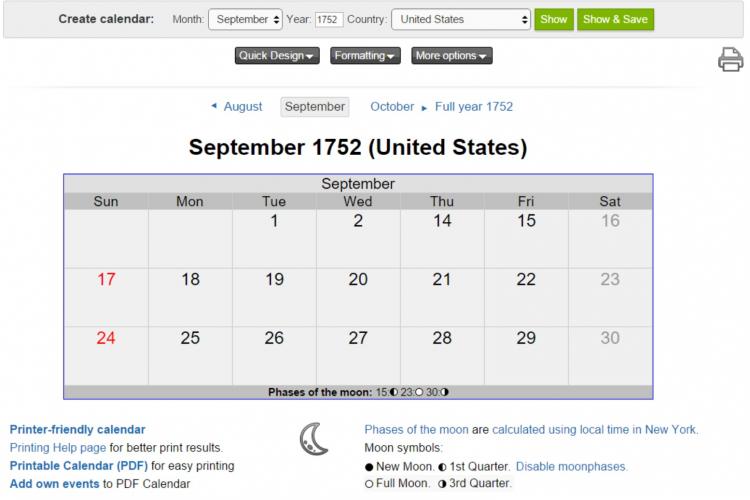The Gregorian calendar was first introduced in 1582, but it took more than 300 years for all the different countries to change from the Julian Calendar.

September 1752 in North America
The Gregorian Calendar, also known as the Western or Christian Calendar, is the most widely used calendar in the world today. Its predecessor, the Julian Calendar, was replaced because it did not properly reflect the actual time it takes the Earth to circle once around the Sun, known as a tropical year.
Too Many Leap Years
The reason the Julian Calendar had to be replaced was the formula it used to calculate leap years. The Julian formula produced a leap year every four years, which is too many. The Gregorian Calendar uses a much more accurate rule for calculating leap years.
Skipped Several Days
To get the calendar back in sync with astronomical events like the vernal equinoxor the winter solstice, a number of days were dropped.
The papal bull issued by Pope Gregory XIII in 1582, decreed that 10 days be dropped when switching to the Gregorian Calendar. However, the later the switch occurred, the more days had to be omitted. (See table below).
This created short months with only 18 days and odd dates like February 30 during the year of the changeover.
In North America, the month of September 1752 was exceptionally short, skipping 11 days.
Switch Took More Than 300 Years
The Gregorian Calendar was first introduced in 1582 in some European countries (*). However, many countries used the Julian Calendar much longer. Turkey was the last country to officially switch to the new system on January 1, 1927.
| Year of Switch | Country | Days Removed |
|---|---|---|
| 1582 | France (most areas), Italy, Poland, Portugal, Spain | 10 days |
| 1583 | Austria, Germany (Catholic states), | 10 days |
| 1587 | Hungary, | 10 days |
| 1610 | Germany (Prussia), | 10 days |
| 1752 | United States (most areas), Canada (most areas), United Kingdom (and colonies) | 11 days |
| 1872/1873 | Japan, | 12 days |
| 1916 | Bulgaria, | 13 days |
| 1918 | Estonia, Russia, | 13 days |
| 1923 | Greece, | 13 days |
| 1926/1927 | Turkey, | 13 days |
* Note: The list includes only a small selection of countries. In some cases, it shows a simplified version of events. Each country is listed by its current name although its official name may have changed since the calendar reform.
| ||
The delay in switching meant that different countries not only followed different calendars for a number of years but also had different rules to calculate whether a year was a leap year.
This explains why the years 1700, 1800, and 1900 were leap years in countries still using the Julian calendar (e.g. Greece), while in countries that had adopted the Gregorian calendar (e.g. Germany), these years were common years.
Double Leap Year
Sweden and Finland had a "double" leap year in 1712. Two days were added to February, creating February 30, 1712. This was done because the Leap Year in 1700 was dropped and Sweden's calendar was not synchronized with any other calendar. By adding an extra day in 1712, they were back on the Julian calendar. Both countries introduced the Gregorian calendar in 1753.
Is There a Perfect Calendar?
Japan replaced its lunisolar calendar with the Gregorian calendar in January 1873, but decided to use the numbered months it had originally used rather than the European names.
The Republic of China originally adopted the Gregorian calendar in January 1912, but it wasn’t used in China due to warlords using different calendars. However, the Nationalist Government formally decreed the adoption of the Gregorian calendar in China in January 1929.
13 Days Behind Today
Currently (1901–2099), the Julian calendar is 13 days behind the Gregorian calendar.
Today's Gregorian calendar uses more accurate leap year formula, making it far more accurate than the Julian. However, it is not perfecteither. Compared to the tropical year, it is off by one day every 3236 years.
The Revised Julian Calendar
This Revised Julian calendar uses even more complex rules to determine when to add a leap day. With an error of only about two seconds per year (or one day in 31,250 years), it is roughly 10 times more accurate than today's Gregorian calendar and one of the most accurate calendar systems ever devised. However, it is not used by any country, only by certain orthodox churches.
No comments:
Post a Comment